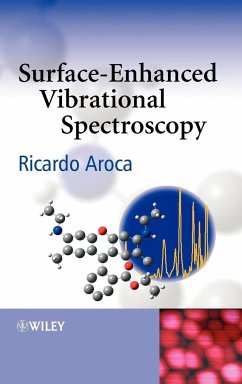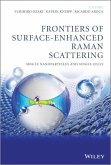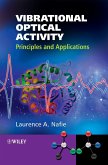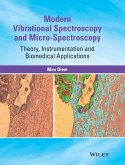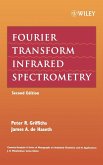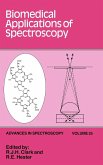Surface Enhanced Vibrational Spectroscopy (SEVS) has reached maturity as an analytical technique, but until now there has been no single work that describes the theory and experiments of SEVS. This book combines the two important techniques of surface-enhanced Raman scattering (SERS) and surface-enhanced infrared (SEIR) into one text that serves as the definitive resource on SEVS.Discusses both the theory and the applications of SEVS and provides an up-to-date study of the state of the artOffers interpretations of SEVS spectra for practicing analystsDiscusses interpretation of SEVS spectra, which can often be very different to the non-enhanced spectrum - aids the practicing analyst
This book discusses two of the many enhanced optical phenomena in surface-enhanced spectroscopy: surface-enhanced Raman scattering (SERS) and surface-enhanced infrared absorption (SEIRA). Together, these form a new branch of vibrational spectroscopy -- Surface-Enhanced Vibrational Spectroscopy (SEVS). SEVS deals with the enhanced spectra of molecules on specially fabricated metal nanostructures with the ability to support surface plasmons and to enhance optical signals. The great advantage of vibrational spectroscopy is that it provides the "fingerprint" of any molecular system; with a large amount of vibrational assignment data for gas, liquid, solid, and, most relevant to SEVS, surface complex systems widely available in the literature. SEVS is an extremely powerful addition to surface-sensitive and single molecule spectroscopies (SMS). The book begins with a review of the vibrating molecule and the origin of infrared and Raman spectra. Chapter 2 contains brief discussions on the absorption and scattering of light by metallic nanoparticles, the fabrication of nanostructures, and the selection of the appropriate experimental conditions for SERS and SEIRA. Chapter 3 is dedicated to SERS as a surface plasmon assisted spectroscopy and includes discussion of the most rudimentary models that provide guidance for the experimentalist. Chapter 4 examines the role in observed SERS spectra of molecule-nanostructure interactions, or chemical effects. Chapter 5 is dedicated to demonstrating that the SERS effect is functional for all molecular types. Chapter 6 presents an overview of SERS applications. The concluding chapter describes surface-enhanced infrared absorption (SEIRA) and its applications. Each chapter contains extensive citation to help the user, and to make the book a useful reference. A glossary is also included to help provide common terminology for those working in the multiple disciplines touched by SERS (chemistry, solid state physics, optics and electrodynamics). A comprehensive reference database of almost 3000 references from the literature from 1980 to 2004 with a listing of references by keyword is provided on www.spectroscopynow.com The book is intended to serve as an introduction for scientists, technologists, and students who may use some aspect of surface-enhanced vibrational spectroscopy in their work. It has been designed to provide a general introduction to concepts and techniques, rather than a strong theoretical or experimental background. Given the multidisciplinary nature of the phenomenon and its applications, the book will be a practical help for anyone in chemistry, physics, biomedical research, or materials science in need of ultrasensitive chemical analysis with high information content, and high spatial resolution.
Hinweis: Dieser Artikel kann nur an eine deutsche Lieferadresse ausgeliefert werden.
This book discusses two of the many enhanced optical phenomena in surface-enhanced spectroscopy: surface-enhanced Raman scattering (SERS) and surface-enhanced infrared absorption (SEIRA). Together, these form a new branch of vibrational spectroscopy -- Surface-Enhanced Vibrational Spectroscopy (SEVS). SEVS deals with the enhanced spectra of molecules on specially fabricated metal nanostructures with the ability to support surface plasmons and to enhance optical signals. The great advantage of vibrational spectroscopy is that it provides the "fingerprint" of any molecular system; with a large amount of vibrational assignment data for gas, liquid, solid, and, most relevant to SEVS, surface complex systems widely available in the literature. SEVS is an extremely powerful addition to surface-sensitive and single molecule spectroscopies (SMS). The book begins with a review of the vibrating molecule and the origin of infrared and Raman spectra. Chapter 2 contains brief discussions on the absorption and scattering of light by metallic nanoparticles, the fabrication of nanostructures, and the selection of the appropriate experimental conditions for SERS and SEIRA. Chapter 3 is dedicated to SERS as a surface plasmon assisted spectroscopy and includes discussion of the most rudimentary models that provide guidance for the experimentalist. Chapter 4 examines the role in observed SERS spectra of molecule-nanostructure interactions, or chemical effects. Chapter 5 is dedicated to demonstrating that the SERS effect is functional for all molecular types. Chapter 6 presents an overview of SERS applications. The concluding chapter describes surface-enhanced infrared absorption (SEIRA) and its applications. Each chapter contains extensive citation to help the user, and to make the book a useful reference. A glossary is also included to help provide common terminology for those working in the multiple disciplines touched by SERS (chemistry, solid state physics, optics and electrodynamics). A comprehensive reference database of almost 3000 references from the literature from 1980 to 2004 with a listing of references by keyword is provided on www.spectroscopynow.com The book is intended to serve as an introduction for scientists, technologists, and students who may use some aspect of surface-enhanced vibrational spectroscopy in their work. It has been designed to provide a general introduction to concepts and techniques, rather than a strong theoretical or experimental background. Given the multidisciplinary nature of the phenomenon and its applications, the book will be a practical help for anyone in chemistry, physics, biomedical research, or materials science in need of ultrasensitive chemical analysis with high information content, and high spatial resolution.
Hinweis: Dieser Artikel kann nur an eine deutsche Lieferadresse ausgeliefert werden.
"I would strongly recommend this book to anyone who is interestedin SEVS." (Physical Sciences Educational Reviews, December2007)
"...provides a healthy balance of theory andexperiment...recommended." (CHOICE, December 2006)
"...this book is a solid investment and an excellentresource for the novice or expert who is interested in awell-developed and acute understanding of the concepts andchallenges surrounding surface-enhanced vibrational spectroscopy."(Journal of the American Chemical Society, December 20,2006)
"The book is well written, easy to read and richly illustrated."(Journal of Solid State Electrochemistry, 2006)
"...provides a healthy balance of theory andexperiment...recommended." (CHOICE, December 2006)
"...this book is a solid investment and an excellentresource for the novice or expert who is interested in awell-developed and acute understanding of the concepts andchallenges surrounding surface-enhanced vibrational spectroscopy."(Journal of the American Chemical Society, December 20,2006)
"The book is well written, easy to read and richly illustrated."(Journal of Solid State Electrochemistry, 2006)

